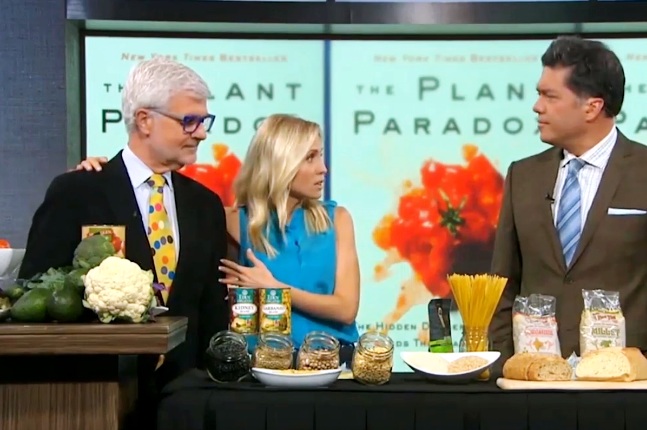
This is a post written by Gundry MD—an elephant partner. We’re honored to work with anyone who is this dedicated to helping us beat our junk-food addictions and finally feel healthy, look healthy, and love our bodies. ~ Ed.
~
If you’re drained of energy, frequently sick, or suffering with indigestion, you’re probably dealing with unhappy gut bugs.
You see, you’ve got a whole universe of bacteria living in your digestive system—trillions of bacterial cells, in fact.
I call these cells your “gut bugs.”
Your gut bugs affect almost every function in your body: your digestion, metabolism, skin, immune system, brain function, and lots more.¹
And there’s a simple way to take care of your gut bugs so your body works better and you feel better.
This helps us:
>> digest our meals better,
>> start craving healthier foods,
>> get clearer, younger-looking skin,
>> get a slimmer body,
>> and start feeling vibrant, fit, and healthy.
The ideal gut bug ratio and how to fix your gut after years of the “SAD”—Standard American Diet:
As I said, there are trillions of bacterial cells in our gut…and there are hundreds of different species, or strains. Most of them are “good” strains: they’re the gut bugs that keep us healthy and help us metabolize food into energy.
But some are “bad” strains: these are the bacteria that make us sick, tired, fat, and unhappy.
Now, everyone’s body is different, but most scientists agree that many Americans are suffering from a major imbalance in their gut.
The influence of lifestyle choices, antibiotics, medications, and particularly diet has caused the “bad” bacteria to grow wildly out of control.²
Let me give you an example of the impact this has on your body, specifically on your weight.
“Fat Strains” vs. “Skinny Strains”
A study³ done at Washington University School of Medicine and published in the highly-respected journal, Science, in September, 2013 found and researched several pairs of “discordant” human twins—which means that one twin was highly overweight, and the other one was lean and healthy.
They took samples of gut bacteria from each twin. Then, they implanted gut bugs from the obese twins into one set of healthy mice…and gut bugs from the lean twins into another set of mice.
The results were unbelievable!
The mice who got bacteria from the lean twin stayed at their normal, healthy weight. But the mice who got bacteria from the “fat twin” gained a massive amount of weight!⁴
This and other studies⁵ ⁶ provide clear proof that there are:
>> fat strains of “bad” gut bacteria, and
>> skinny strains of “good” gut bacteria
…and that our weight is affected by the balance of “good” to “bad” bacteria in our gut.⁷
And the fact is, your “good” strains crave different foods than your “bad” strains.
1. Your fat strains of gut bugs love sugar. They also crave artificial sweeteners, refined carbs, and processed foods—in other words, all the things that make us fat.
2. Your skinny strains of gut bugs crave something called prebiotic fiber which works like a “superfood” for them.
So, if you want to restore health to your gut, reducing sugar is only one part of the solution. You’ve also got to feed your “good” gut bugs the prebiotic fiber which helps them multiply.⁸
The bottom line is: restoring your gut bacteria to its ideal ratio will help you feel better in so many ways—including helping you lose weight.⁹
How to fix your digestion and reduce junk-food cravings by feeding your gut bugs what they need:
Prebiotic fiber is essential for good digestion and metabolism¹⁰—but what’s really amazing is how it can help control your cravings for fattening and unhealthy foods.
Certain foods are naturally high in prebiotic fiber, including: tubers, rutabagas, parsnips, Jerusalem artichokes, chicory, and a few others.
Now, these foods are all great for you—but, let’s face it, these are not the kinds of foods most of us eat every day. If you wanted to get the highest dosage of the right kinds of prebiotic fibers in your diet, you’d have to eat a lot of rutabagas!
That’s exactly why I developed a blend of five potent prebiotic ingredients in a new formula from Gundry MD.
This new method will help:
>> Give you easier digestion and improve metabolism,
>> Convert more of your food into energy, instead of fat,
>> Boost your immune system, so you get sick less often,
>> Improve the health and appearance of your skin,
>> And help stubborn fat leave your body, as you no longer crave the sugary, toxic foods contributing to it.
I want you to just try this formula.
Feel how it improves your digestion, how it helps you feel better after meals without abdominal discomfort, how it helps reduce cravings for sugary foods.
And if you don’t like your results, you simply won’t pay for it.
Shipping is free on all U.S. orders
Multi-jar packages to suit your family’s needs
90-Day Satisfaction Guarantee
100% all-natural, safe ingredients
I’m confident this will transform the health of your gut and give you back the lean body you deserve.
Please don’t hesitate, watch this video today to learn more.
Looking out for you,
Dr. Steven Gundry
~
Learn more about Dr. Gundry:
Sources:
1. Yu-Jie Zhang H. “Impacts of Gut Bacteria on Human Health and Diseases.” Int J Mol Sci. 2015 Apr;16(4): 7493-7519. doi: 10:3390/ijms16047493.
2. Yu-Jie Zhang H. at 7493-7519.
3. Ridaura VK, Faith JJ, Rey FE, et. al. “Cultured gut microbiota from twins discordant for obesity modulate metabolism in mice.” Science. Sep 6 2013; 341 (6150): 1241214. DOI: 10.1126/science.1241214.
4. Ridaura VK et. al. at 1241214.
5. Ding SL, Chi MM, Scull BP, et. al. “High-fat diet: Bacteria interactions promote intestinal inflammation which precedes and correlates with obesity and insulin resistance in mouse.” PLoS ONE. 2010;5:e12191. doi: 10.1371/journal.pone.0012191.
6. Hildebrandt MA, Hoffmann C, Sherrill-Mix SA, et.al. “High-fat diet determines the composition of the murine gut microbiome independently of obesity.” Gastroenterology. 2009;137:1716–1724. doi: 10.1053/j.gastro.2009.08.042.
7. Ley RE “Obesity and the human Microbiome.” Curr Opin Gastroenterol. 2010 Jan;26(1):5-11/ doi: 10.1097/MOG.0b013e328333d751.
8. Slavin J. “Fiber and Prebiotics: Mechanisms and Health Benefits.” Nutrients. 2013;5(4):1417-1435. doi: 10.3390/nu5041417.
9. Ley RE at 5-11.
10. Gibson G.R., Roberfroid M.B. “Dietary modulation of the human colonic microbiota: Introducing the concept of prebiotics.” J. Nutr. 1995;125:1401–1412.
~
Images: Gundry MD; Chinh Le Duc/Unsplash








Read 4 comments and reply